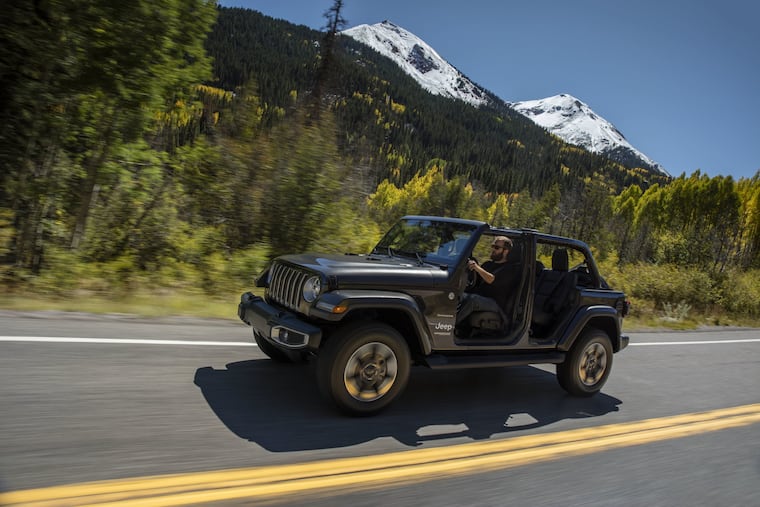Jeep offers two economical ways to Wrangle
The 2021 Jeep Wrangler offers two engines with greater efficiency — the 2.0-liter four-cylinder turbo and the 4xe model, which is a full plug-in hybrid model. How do they compare?

More power, more economy: 2021 Jeep Wrangler Unlimited Willys 4x4 vs. Jeep Wrangler Sahara 4xe.
This week: Wrangler Unlimited 4x4 (Unlimited denotes it’s the four-door, by the way.)
Price: $50,265 as tested. Options added darn near $20,000 to the price. I mention what’s relevant where I can, but, geez, Jeep.
Conventional wisdom: Car and Driver likes the “iconic and unique design, legendary off-road capability when properly equipped, removable doors and roof,” but not the “tight passenger space, noisy at highway speeds, inaccurate steering, rougher ride than more car-like rivals.”
Marketer’s pitch: “The icon.”
Reality: Will a mild-hybrid 4-cylinder really bump fuel economy without sacrificing performance?
What’s new: It’s the beginning of summer, and you want to get out in the sun. There is no better way to do this than in a Jeep Wrangler — but be sure the skies will stay clear, because the doors and roof don’t come along for the ride. (Ask me how I know.)
Now Jeep offers two fuel-efficient power trains (well, fuel efficient-ish, see below), one of them a full hybrid, and there’s so much to say about the Wrangler that we’ll spend two weeks saying it. So buckle up, it’s going to be a bumpy ride.
» READ MORE: 2021 Volvo XC60 Recharge adds power and economy to winning luxo-SUV
Up to speed: The Jeep Wrangler has always had plenty of motivation — the base 3.6-liter V-6 features 285 horses and rocks the Wrangler to 60 in 6.1 seconds, according to Car and Driver. This is the engine Mr. Driver’s Seat has previously tested, in Wrangler and Gladiator alike.
Now, let’s take a little detour to talk about fuel efficiency and power for a minute, kids. We’ll pick a 1982 Jeep CJ-5 for comparison, because that’s when young Master Driver’s Seat would have been drooling over his dad’s friend’s hand-me-down Car and Driver magazines in his bedroom and ignoring his homework.
The 2.5-liter four-cylinder that American Motors offered created a whopping 84 horses, according to Automobile Catalog, and it dragged the little off-roader kicking and screaming to 60 mph in a mere 15.6 seconds.
Now, Stellantis (the new Fiat-Chrysler-Peugeot conglomerate) brings us a 2.0-liter turbo four Italian-sourced since the 2018 redesign. This engine creates 270 horsepower, and coupled with a mild hybrid that adds torque for acceleration and restarts it for stop-starts, it takes the Wrangler to 60 mph in 6.5 seconds, according to Car and Driver. And the 295 pound-feet of torque really pushes the vehicle forward in a hurry.
So evidently we’ve come a long way in the power department. The fuel economy? Ask again later.
Shifty: The 8-speed shiftable automatic ($1,500) chooses gears the way I type: hunt and peck. Ninety percent of the time it works just fine, but that last 10% is pretty obnoxious. The worst usually happens after turning and then starting up a small hill.
Fortunately, the Wrangler comes with a nice big gearshift lever, so drivers can choose gears to their heart’s content. This mode operates nicely.
(A six-speed manual remains standard on the Wrangler. Yay. But only with the 3.6-liter V-6. Boo.)
On the road: A Wrangler will always wrangle the curves just as it always has. It’s fun because it’s a Jeep, and in nice weather, the doors are removed and you can watch your feet sail past the road’s edge. Keep hands and feet inside the ride at all times.
The steering is more direct on winding roads than it is on straightaways, where the big tires and old-timey suspension require frequent corrections to keep the SUV moving in something like a straight line. It feels like walking with the Sturgis Dogs 1.0 through 3.0, who like to zig this way and that, but mostly we still have a lot of fun. Mostly.
» READ MORE: Subaru gives the 2022 Outback Wilderness all the off-road moves
Driver’s Seat: Buyers can pay a lot of freight and still only get cloth seats. They’re nice enough and comfortable, but dog hair grabs on and won’t let go. Adjustments are easy but the recline strap can disappear, making the uninitiated a little confused for a few moments.
(We’ll tackle passenger space and stereo sound next week.)
Keeping warm and cool: The heater fan control knob matches the radio knobs and sits between them, making for some initial confusion as well. The rest of operation happens via buttons. Round vents are simple to direct and look attractive.
The cloth seats are heated as well (part of the $995 Cold Weather Group, which also adds remote start), a setup which is not as rare as it once was.
Fuel economy: I averaged around 18 mpg close to home and scooched it up to 19 for that longer trip up north, so we’re getting a little better here with the turbo 4. (The V-6 showed 15-17 mpg in the 2018 model.) It’s a 10% improvement over the larger engine, but it’s like the boss who makes a couple hundred grand a year telling the minimum-wage slave “We both got 10% raises!” It’s not that big a help.
Feed the Wrangler whatever.
Where it’s built: Toledo, Ohio
How it’s built: Consumer Reports predicts the reliability to be a 2 out of 5.
Next week: Saving some fuel with the Jeep Wrangler Sahara 4xe. Will performance suffer?